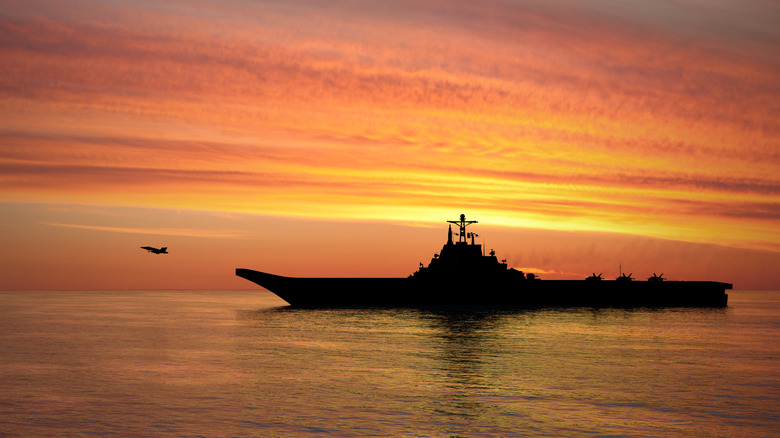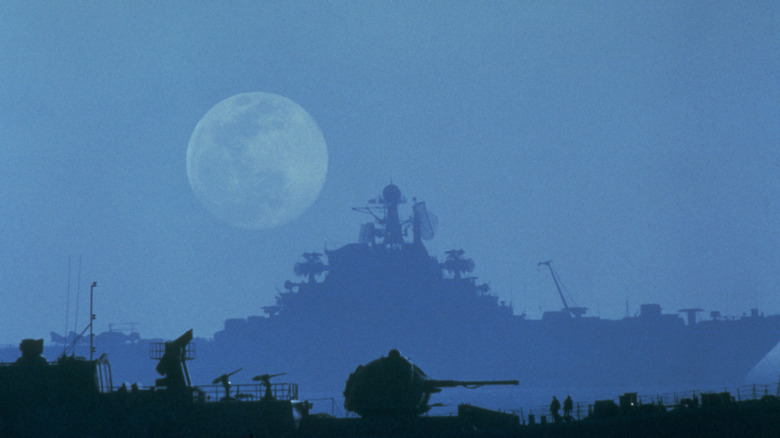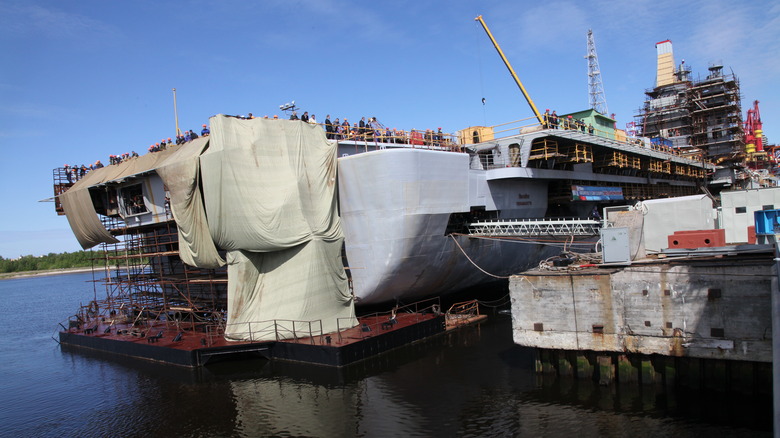What Happened To Russia's Aircraft Carrier Fleet After The End Of The Cold War?
One of the most fascinating facts to discover about world militaries is that Russia only has one aircraft carrier in its service. Even more interesting is that the carrier has been undergoing upgrades and repairs since 2018. So it's not even out sailing around like the United States' 11 nuclear aircraft carriers. Well, they're not all deployed either, since many are undergoing refits/repairs.
It wasn't always this way: During the years of the Cold War, the Soviet Union had seven aircraft carriers from three different classes, and they transported a mix of helicopters and fighter jets. One might wonder how a country can go from owning seven carriers to just one. Well, the collapse of an entire government isn't kind to the economy.
When the Soviet Union collapsed in December 1991, it had to undergo a significant transition period. There were a few growing pains during this period, one of which was the collapse of the Soviet ruble. For a short time, bricks were more valuable than the ruble in the newly formed Russian Federation. Russia was forced to decommission all of its carriers between 1991 and 1996 to cut costs, with the only surviving carrier being the Admiral Kuznetsov.
Russia was able to stay afloat by selling off a few of its carriers to allied nations. The Kiev-class carrier — the Baku — survived the scrap heap as well, finding itself in service of India's navy. China purchased a few carriers, too; transforming them into hotels and museums.
The Soviet Union's aircraft carriers
The first type of carrier the Soviet Union built was a Moskva-class carrier, with the Moskva being the first of the two in its class. The Moskva and then Leningrad were commissioned in 1967 and '69, respectively. However, it wasn't the typical carrier that the general public would come to know in the 21st century. The Moskva-class ships were helicopter carriers that could transport 14 helicopters around the ocean. Their primary mission? Hunt the best nuclear submarines from the Cold War era and protect Soviet submarines. The helicopter carriers were armed with a set of torpedo launchers and a pair of mortars to combat enemy subs. Furthermore, they were capable of launching a five kiloton nuclear warhead.
It wasn't until 1975 that the USSR built its first fixed-wing carriers. They built four Kiev-class carriers, consisting of the Kiev, the first of its class, followed by the Minsk, Novorossiysk, and the Baku. These capital ships fulfilled multiple roles, on top of launching aircrafts. The front half of the ships were armed to the teeth with SS-N-12 Sandbox anti-ship missiles, SA-N-3 surface to air missile launchers, eight AK-630 30-millimeter gatling guns, and anti-submarine rocket and torpedo launchers. Each Kiev could also launch a 350 kiloton nuclear warhead intended to breach U.S. carrier battle group defenses.
The Kiev carriers could hold up to 22 Yak-38 "Forger" jets, the only VTOL aircraft in the Soviet arsenal. However, since they took on anti-submarine roles as well, the carriers cut that down to half so they could carry a dozen Ka-25 helicopters.
The carriers Russia sold and scrapped
By the end of the Cold War when the USSR was split up and its remaining territories became part of the Russian Federation, the government couldn't afford to maintain its existing carriers. This left Russia with a couple options: They could either scrap the carriers they had, or they could sell them off to other countries for a chance to keep its budget afloat. Construction for one of two carriers in the new Kuznetsov-class had just finished, which turned into the sole Russian carrier. The second in its class, the Varyag, was sent to the Ukraine to be scrapped since they never even completed the electronics system for it.
It was eventually sold off to a Chinese investor to be turned into a floating casino — but that turned out to be subterfuge, as he really intended to pass it on to China, where it became China's first aircraft carrier. Before that, China had purchased two Kiev-class carriers, the Kiev and Minsk, which were converted into a hotel and an amusement park, respectively.
The Kiev-class Baku went through a few name changes over the years, becoming the Admiral Gorshkov after the Soviet Union fell, and then the INS Vikramaditya in 2013 after India purchased it and inducted it into its navy. The USSR had plans to build a fifth Kiev-class carrier, but it never got off the ground before the Cold War ended.


